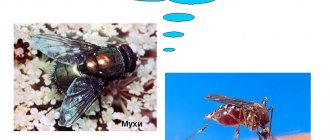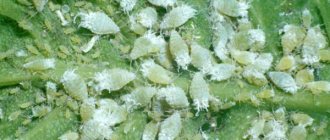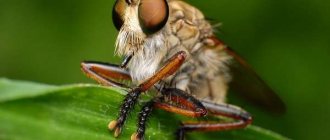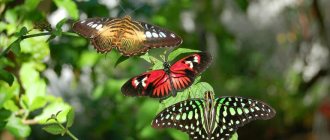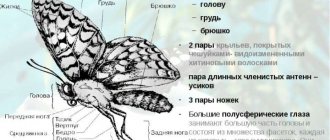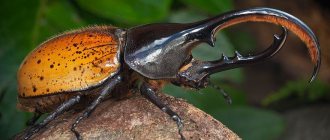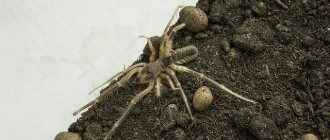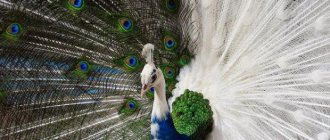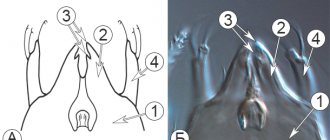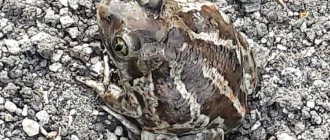Dragonfly larva and brief characteristics of the order
Dragonflies are a group of flying predatory insects. Representatives of this group of animals are distributed in the tropics, subtropics and areas with temperate climates. To date, about six thousand representatives of this order are known. These insects are characterized by an indirect mode of development, which includes a transitional stage (dragonfly larva) and an imago stage (adult). Both larvae and adults form the basis of the diet of some fish species. What are dragonflies?
What do adults look like?
Before the dragonfly larva is considered, it is necessary to learn more about the way of life of these insects. The adult is quite large, with a pronounced and mobile head. The organ of vision is the huge compound eyes, which occupy the entire upper part of the head. The insect's body is elongated and consists of a thoracic and abdominal part. The dragonfly's limbs are not very well developed, but they have bristles arranged in rows that act as a hunting basket, making it possible to hunt in flight.
Representatives of this group have two pairs of wings, which are almost the same size and actively participate in flight.
What do dragonflies eat? As already mentioned, these are predatory insects. Smaller species become their prey. Mostly these are midges, mosquitoes and other insect pests. The dragonfly itself usually becomes food for fish.
Reproduction and development of dragonflies
These insects mate in flight. On the abdomen you can see developed copulatory organs - in this way it is easy to distinguish a male from a female. Another interesting feature is that the male removes foreign sperm from the female’s copulatory apparatus before placing his own there. This phenomenon has no analogues in the wild.
The female then lays fertilized eggs. As a rule, oviposition is carried out either in water or on aquatic plants and much less often in moist soil. From each egg a dragonfly larva emerges.
The larvae of these insects live in water. Their body is olive-brown in color. They breathe using rectal gills and through the integument of the body. These creatures are inactive, but the way they move is worthy of attention. First, a portion of water is sucked through the anus, which is then sprayed out from there under high pressure. The recoil force pushes the insect in the opposite direction. In addition, the dragonfly larva can swim using gill plates, which perfectly replace fins.
Another feature of the larva is the presence of a so-called mask, which is represented by an overgrown lower lip. The mask plays the role of a grasping apparatus. Insects at this stage of development do not actively hunt - most of the time they sit on the bottom or attach themselves to an aquatic plant, waiting for prey, which they then grab, quickly throwing the mask forward.
The dragonfly larva feeds mainly on daphnia, mosquito larvae and other insects. Before the last molt, the insect climbs ashore and attaches itself to a plant. It is here that the larva transforms into an adult form - an adult.
It is worth noting that dragonflies are a fairly common group of insects. The order is further divided into two main suborders:
- Homoptera dragonflies. Representatives of this order have pairs of wings of equal size. Thanks to this structure, insects are characterized by a soft, fluttering flight. The larvae of such dragonflies live in flowing or stagnant bodies of water.
- Varied dragonflies. These insects have two pairs of large, almost transparent wings. In a calm state, their wings are placed perpendicular to the abdomen. It is worth noting that representatives of this group are considered one of the fastest insects. The larvae live either in a pond or in a swamp.
Interestingly, experienced fishermen quite often and successfully use these insects as bait.
We recommend checking out: https://fb.ru
It is very typical for the entire order of spiders to replace the primary copulatory organs absent in males with peculiarly modified pedipalps, or gonopalps, as V. Dogel (1940) calls them. Among arachnids, similar sperm transfer organs are present only in Ricinulei (on the third pair of legs), and in general are very rare (for example, the hectocotylated tentacle of Cephalopoda males).
The copulatory organs reach full development only after the last molt of the male; Before this, there are no particularly significant differences in the pedipalps of the male and female.
Description and features
Dragonflies are flying predatory insects. They belong to the order of dragonflies, which has more than 6,000 species. The sizes of insects, depending on the species, range from 1.5 to 15 cm, and the wingspan is from 2 to 19 cm. The appearance of the dragonfly is easily recognizable. The insect has a large head with large eyes, short antennae, powerful mouthparts, chest, abdomen, three pairs of legs and two pairs of wings. Body color can be very different; dragonflies of various colors are found in the world. Some of them have a metallic sheen to their body.
Appearance
The dragonfly's head is very mobile and can rotate 180⁰. The eyes consist of a large number of facets (from 10 to 27 thousand). The lower rows of eye elements can only perceive the colors of objects, and the upper ones their shape. There are 3 simple eyes located on the crown. This structure and location of the eyes makes it possible for the dragonfly to survey the surrounding space not only in front of itself, it sees what is happening from the side, above and even behind.
But with the other senses the situation is much worse. Insects have a very weak sense of smell, and hearing is practically absent. The gnawing type oral apparatus is formed by strong, durable jaws, which are covered by the upper and lower lips.
The main feature that distinguishes dragonflies from other insects is their elongated abdomen, which makes up most of the body. The wings are large, transparent, consist of 2 layers of chitin and have many overlapping veins.
The tarsi consist of 3 segments, each of which is covered with small spines. The dragonfly needs its paws for grasping and holding prey, as well as for taking off and landing. Insects practically do not use them to move. During flight, the legs fold into the shape of a basket. This helps the insect instantly grab prey that gets in its way.
Features of dragonflies
The structure of these organs is most clear in some Haplogynae, for example in Segestria (Fig. 83) and Scytodes. Proximally, on the tarsal segment of the pedipalp, a large pear-shaped appendage (bulbus genitalis), elongated into a thin spout (embolus), develops.
At the end of the spout lies a small hole leading into a long, spirally coiled, chitin-lined sperm reservoir, or spermophore. During mating, the embolus is inserted into the female's seminal receptacle.
The proximal position of the bulb appears to be secondary. In many other primitive spiders (Aviculariidae, Hypochilusy Oonopidae, etc.), the copulatory apparatus is almost as simple, but the bulb is located subterminal or even completely terminal. In Hypochilus it is partially immersed, while in Filistata it is entirely immersed in the invagination at the end of the tarsal segment.
With the complication of the copulatory apparatus (Fig. 84), a second appendage develops next to the embolus - the conductor, which serves as a vagina or sheath for the embolus and facilitates the introduction of the latter into the copulatory opening of the female (Atypus, Caponia, etc.).
The base of the bulbus, already in Segestria and Scytodes, is movably articulated with the tarsus by means of an articular membrane.
Growing strongly in Aviculariidae, Atypus and other forms, the latter acquires the ability to swell with blood. In Entelegynae, the articular membrane turns into a special sac-like organ - a blood receptacle, or haematodocha, which folds at rest, but at the moment of mating it expands, swelling like a bubble under blood pressure.
The blood receptacle is located in a deep hole (alveolus) on the surface of the tarsus, which is called the boat (cymbium). Sometimes the tarsus is shortened to the size of a small scale (Nephila). Often in Entelegynae the copulatory apparatus reaches extraordinary complexity. One of its significant changes is the spiral twisting of the inflated blood receptacle and the bulb itself. The spermophore, which already in Segestria has a spiral course, here is strongly elongated and twists repeatedly; in addition, its individual sections can be differentiated in the form of special glandular organs (Linyphiidae).
Complications in the chitinized parts of the apparatus are also significant, and most importantly, very diverse and serve in taxonomy as an excellent criterion for distinguishing species. The bulb can take various shapes and become very complicated due to the formation of special sclerites or membranous parts on it.
The first are represented by the so-called retinacula (hetinacula) - chitinous appendages of various shapes that serve to attach the bulb to the female copulatory organs during mating. The second, called hematodochulae, are membranous areas that are functionally similar to a blood receptacle and can, like it, swell when filled with blood.
Quite often the embolus becomes more complicated. In Entelegynae, it forms a sharply isolated chitinized appendage and often turns into a flexible, spirally twisted hollow thread, the length of which can exceed the length of the body (Delena, Isopoda - from Sparassidae, Hyptiotes - from Uloboridae, Tegenaria - from Agelenidae and Labulla - from Linyphiidae).
In parallel with the embolus, the conductor is lengthened and usually twisted. From a simple embolus case, it turns into a special targeting device. Twisting of the embolus and conductor occurs in one direction (Isopoda) or in different directions (Dictyna, Tegenaria ferruginea).
Sometimes the entire copulatory apparatus reaches a very significant size. Thus, in Theridiosoma and in some related genera of Araneidae, the bulbus is the same size as the entire cephalothorax.
Finally, often (Tetragnathidae, Araneidae, Linyphiidae) a special outgrowth also develops on the tarsus - paracymbium, which serves for attachment during mating; sometimes attachment hooks even develop on the tibia and femur of the pedipalp.
The male copulatory apparatus of Pholcidae stands apart.
In simpler cases (Ninetis, Modismus, etc.) the bulb has a simple pear-shaped shape, but in other genera it is very complex. Thus, in Pholcus phalangoides, in addition to the embolus, the bulb bears two more outgrowths. One of them, the uncus, is covered with peculiar scales, the other, the T-shaped appendix, is heavily chitinized. The tarsus also forms a distal outgrowth called procursus, which carries a soft membrane stretched between the teeth, which swells at the moment of mating.
In the question of the phylogenetic development of the male copulatory apparatus, decisive importance belongs to observations of its formation in ontogenesis.
As Burrows (1925) and Harm (1931, 1934) showed, in the ontogeny of Segestria and Salticidae the bulbus develops from the pretarsal segment, and the embolus from the claw. Accordingly, in Mugalomorphae (Eurypelma), the tendons of two muscles are attached to the base of the copulatory organ, in which it is easy to recognize the usual levator of the claw segment, attached, as in the unmodified pedipalp, in the tarsal segment, and the depressor, lying, as usual, in the tibia (Snodgrass, 1952). Obviously, the most primitive types of the copulatory apparatus should be sought in those spiders in which it is located terminally, such as, for example, Aviculariidae, Hypochilus, Filistata, Oonopidae (Comstock, 1913; Berland, 1932).
In Lipistius, on the contrary, the position of the apparatus is secondarily changed, and its high specialization indicates a special path of evolution of this genus.
In general, three types of copulatory apparatus are distinguished: a simple type Segestria, a complicated type characteristic of most Entelegynae and others, and a special type characteristic of Pholcidae. The first two represent successive stages of development; the formation path of the third type was probably special and independent.
There are 5,000 species of dragonflies in the world.
Photo of dragonfly
Dragonflies (Libellulo sp.) The scientific name of these insects comes from the Latin word LIBELLA, which means “little scales.” The horizontally spread wings of a dragonfly in flight really resemble balanced scales. In recent years, several species of dragonflies have become extremely rare, but there are still more than 5,000 species of these wonderful insects in the world, more of them in warm countries.
Great rocker (Aeschna grandis)
| Magnitude | Body length 8 cm, wingspan 11 cm |
| Signs | 2 green spots on the abdominal rings; males have 2 oval yellow-green spots on the chest and blue spots on the abdomen |
| Nutrition | The prey of dragonflies is primarily other insects and their larvae; adult dragonflies hunt in flight, with their legs forming a real trap; prey is eaten on the fly or after landing; larvae live in water and grab prey (insect larvae, worms, tadpoles) using a trap mask on their head |
| Reproduction | The larvae hatch in late April–early May from overwintered eggs; Development into an adult animal usually lasts 2 years |
| Habitats | Everywhere near ditches, ponds and lakes, and sometimes far from bodies of water; distributed in Europe, Asia Minor and North Africa |
Dragonflies are a group of fairly large insects capable of active flight. They have an elongated slender body, strong legs, a large head with antennae and large eyes. The eyes have a complex structure and consist of facets; each eye has 30 thousand facets. That part of the facets, which is located in the upper part of the eye, distinguishes only the shape of objects, and the facets located in the lower part of the eye distinguish colors. This eye structure allows the dragonfly to navigate well and hunt successfully.
The dragonfly has four transparent wings with many veins, which provide it with confident flight. The wingspan of modern dragonflies can reach 19 cm, and the body length can be up to 12 cm. Females are usually inconspicuously colored, while the body of males has a bright shiny color.
Spreading
Dragonflies are widespread on all continents except Antarctica. Most species of modern dragonflies live in subtropical and tropical zones. A very wide variety of dragonflies can be observed in South America.
Dragonflies can live where there are bodies of water, favorable temperatures and sufficient food. They can be found in meadows, forests, steppes and mountains.
Nutrition
All dragonflies are predators. They hunt various insects. Moreover, some types of dragonflies attack their prey directly in flight, while others hunt insects on the leaves and stems of plants.
Dragonfly larvae live in water and can eat worms, insect larvae, small crustaceans and even fish fry.
Lifestyle
Dragonflies go through three stages of development - egg, larva (nymph) and imago (adult animal).
During the breeding season, females lay eggs near water, in water, or in rotting wood lying in water. Over its entire life, a dragonfly can lay from two hundred to several thousand eggs.
Over time, the eggs hatch into larvae that develop and live in the water. To live underwater, they have well-developed gills. The larvae have a gnawing-type mouthparts with a powerful retractable lip, which is excellent for grasping and holding prey. Larvae, like adults, are predators. Living in water, they cannot swim, but they easily move along the bottom on their strong paws. In water, the larva can live from one to four years. During this period, the larva molts up to 25 times. After this, the larva crawls onto the stem of a plant and molts for the last time, turning into an adult dragonfly capable of flight.
- In dragonflies, the hearing organ is located on the antennae.
- Dragonflies can fly at a speed of 50 km/h.
- The largest modern dragonflies live in South and Central America. Their wingspan reaches 19 cm, and their body length is 12 cm.
- Prehistoric dragonflies that lived in the Permian period had a wingspan of up to 70 cm.
Graceful hunter - dragonfly
These are the largest flying insects. All of them are divided into heteroptera and homoptera. Different-winged dragonflies are larger in size than even-winged dragonflies, and besides, they fly better.
The insect's body consists of a head, chest and long abdomen, at the end of which there is a pair of forceps. Body length 3 - 12 cm. Color varied: white and green, yellow and red, blue and orange.
Graceful transparent wings are its decoration. There are many transverse and longitudinal veins on the wings, which have a strengthening function. A dark spot on the wing protects the fly from vibration in flight.
Agile flyers develop colossal speed; some species can cover distances at speeds of 100 km/h.
Basically, the flight speed of the “jumper” is 5 km/h. They cover hundreds of kilometers without stopping, and can expertly hover in the air and suddenly stop. When she sits on a branch or any solid ground, her wings do not fold, they are always in a straightened state.
Each individual has three pairs of legs covered with shields. In flight, they fold their limbs into a basket - this makes it more convenient to grab prey.
Their mouthparts are of the gnawing type. The lower lip is a harpoon, shoots and grabs prey. Large eyes help track prey and can see anything edible at a distance of 10 meters. The structure of the eyes is complex - faceted.
All dragonflies are predators. They feed mainly on mosquitoes, flies, moths and other insects, which they pursue with great speed.
Dragonflies live in Europe, Asia, America, Australia, and Africa.
They can be found in meadows, forest edges, fields, but there must be a body of water nearby. They lead a solitary lifestyle. Enemies - many birds, spiders.
When courting a female, the male performs a mating flight, at the same time driving away other contenders. Soon the female will lay about 200 eggs in fresh water, either in wood or on various parts of the plant. The development of an insect consists of three stages: egg - larva (naiad) - adult.
The larvae are inactive and spend their development in the fresh waters of the reservoir. In some species, development can last 5 years. Larvae with huge eyes They are ferocious and voracious predators, they can even eat their relatives.
They wait for hours for their prey to hide, and as soon as it appears in sight, they immediately attack it. They feed on aquatic insects and their larvae and fry. Having lived in the reservoir for the required period of time and shed several times, the naiads climb out of the water along the stems of aquatic plants.
Having dried, they molt for the last time, and a beauty with wings is born. A few more moments and she will fly into the sky.
Despite their predatory lifestyle, insect larvae are often easy prey for other natural inhabitants, such as fish. Out of one hundred eggs, only three individuals survive to the adult stage. Adults live for about a month and then die.
In the wild, dragonflies live for 7 years.
The fauna that surrounds humans is rich and diverse. Knowledge about some creatures will help us understand and realize what is around each of us. This article discusses orders of insects: dragonflies, lice, beetles, bedbugs, which are most often encountered in people's lives.
Natural enemies of dragonflies
Due to the fact that larvae and adult insects live in different environments, their enemies are also different. The danger for larvae is:
- predatory and omnivorous fish;
- birds living on shallows and near bodies of water (herons, waders, etc.);
- swimming beetles and their larvae;
- some species of water bugs.
Adult dragonflies are hunted by:
- orb-weaving spiders, tetragnathid spiders, hobo spiders;
- blackflies;
- birds (including bee-eater, white wagtail, gulls, ducks, swifts, woodpeckers).
Enemy of the dragonfly
In addition, dragonflies can become prey for carnivorous plants. Most often these are varieties of sundews growing in sphagnum and peat bogs. To date, no enemies of dragonflies have been found among mammals and reptiles.
Considering that adult insects are quite cautious, fly quickly and maneuver deftly in the air, it is not easy to catch them. A predator can eat a dragonfly only if it takes the insect by surprise, which does not happen often.
General characteristics of dragonflies
General characteristics help to understand what each unit is.
Dragonflies are the largest flying insects on Earth. They are predators. The order of dragonflies includes suborders: heteroptera and homoptera.
Like the dragonfly, the louse's characteristics are quite simple.
These insects are blood-sucking parasites. They belong to the order of lice eaters. The general characteristics of lice do not form any suborders. By parasitizing on humans, they cause lice, or lice are scientifically the causative agents of pediculosis. Beetles are the most numerous inhabitants in the world. There are about 300 thousand species of them. All of them form the order Coleoptera. Bedbugs are numerous representatives of the order Hemiptera.
What does a dragonfly eat?
Dragonflies and their nymphs feed exclusively on prey. They usually hunt prey in flight, but some species wait in place and take off after prey only when they see it.
Particularly large dragonflies often devour their prey in flight. Thanks to their excellent vision, they can see prey at a distance of up to 2-6 meters. They first grab the prey with their legs, then pull it towards their mouth. Their prey is usually any flying insects, sometimes other types of dragonflies (often a dragonfly catches a butterfly).
The nymph hunts with the help of a so-called mask, which is a reshaped lower muzzle with a grasping device. She can extend the mask up to a third of her body and use it to drag prey to her mouth. Most often they prey on the larvae of other aquatic insects.
Variety of dragonflies
Today, more than 6 thousand species of dragonflies are known.
They are distinguished by their color, which can be very different, and their size, which can be from 3 to 12 centimeters. There are several thousand species of lice. But among this huge variety of lice, only three types are dangerous for humans: head, body and pubic. They differ in their habitat.
The entire variety of beetles can be divided into 6 families: predators, weevils, longhorned beetles, leaf beetles, ground beetles and lamellar beetles.
The variety of bedbugs is very large. The most famous of them are house bugs that feed on human blood.
Is the large rocker dragonfly dangerous for humans?
The dragonfly is absolutely not dangerous for humans; as mentioned above, it is not capable of biting through the skin of people, so you should not be afraid of its bites.
The large rocker dragonfly is an insect useful to humans, because it helps in the fight against blood-sucking insects. Imago dragonflies attack botflies and mosquitoes on land, and nymphs eat their eggs in water.
Despite its advantages, dragonflies can cause harm to humans. Adult insects prey on bees, and the larvae feed on eggs and fish fry.
Appearance of a dragonfly
Most often, we distinguish representatives of the animal world by their appearance.
Dragonflies have a long and thin body, which is connected to a small round head by the thorax. On the body there are 3 pairs of legs, as well as 2 pairs of long transparent wings, which can have the same shape in homoptera dragonflies and different shapes in heteroptera. Large eyes and antennae are clearly visible on the head.
Lice are small insects whose size does not exceed 5 mm. Their body is slightly flattened and brown in color. The biology of the louse implies the presence of three pairs of single-jointed legs and a small head. Initially, lice had wings that were quite developed. But with a parasitic lifestyle, they lost their functions and decreased in size.
The appearance of beetles can be very different.
They come in different colors. Their sizes vary from a few millimeters to 15 centimeters.
All beetles have a large elongated body, a small head, a three-segmented thorax, and 3 pairs of five-segmented legs extending from the body.
Bed bugs can also be found in nature in different sizes and colors.
Their body is generally round in shape and their head is small.
Life activity of dragonflies
Dragonflies live on lawns, fields, and near bodies of water in different countries with temperate climates. Insects lead an active lifestyle, flying over considerable distances.
When landing, a dragonfly always spreads its wings, unlike many insects. Insects prefer to hunt alone during the day.
The dragonfly silently creeps up to the victim and captures it, folding its legs into a “basket”. These arthropods easily dodge dangerous predators in the air, thanks to the special structure of their eyes and considerable flight speed.
Structural features
The same parts of the body can perform completely different functions in different animals. They depend on the animal’s lifestyle and environmental conditions.
Structural features of dragonflies
The eyes of dragonflies have a complex structure.
Their good vision is due to the fact that their upper part recognizes the shape of objects, and the lower part recognizes colors. To ensure the strength of the wings, veins are located along their entire length, and at the end you can see dark spots that reduce vibration during flight, thereby preventing wing fracture.
Dragonflies can make various beats of their hind and front wings for balance and synchronized ones for speeds that can reach 50 km/h. The lower lip is well developed and very long. It allows you to deftly grab prey. To hunt, the dragonfly compresses its legs while flying.
Features of the structure of lice
Lice have a sucking type oral apparatus, represented by two tubes: one for piercing the skin, and the second for sucking blood.
Another feature of the structure of lice is that during a puncture, a substance is released that stops blood clotting. The structure of the eyes is simple.
They may be completely absent. This suggests that lice do not use vision to move; their sense of smell helps them in this. This structure of lice is determined by their parasitic lifestyle.
Structural features of beetles
The main feature of beetles is their wings. They are double: the upper pair hardened during evolution and formed a chitinous shell, while the lower pair remained transparent and veiny.
This structure protects the beetle's body. They have a chewing-gnawing mouthparts.
Features of the structure of bedbugs
Bedbugs have glands on their chests that secrete an odorous enzyme. It is unpleasant to humans and resembles the smell of almonds. It serves to scare away enemies.
The benefits and harms of dragonflies
Like many other insects, dragonflies cannot be called clearly beneficial or harmful. Their benefit is that adult individuals feed on insects, and therefore play a significant role in the regulation of certain types of blood-sucking insects (including such dangerous ones as horseflies or tsetse flies), pests of agricultural crops and forests. In addition, dragonflies participate in pollination. Flying from flower to flower, they carry pollen on their legs. Fish and crustaceans feed on the larvae of these insects. Fishermen often use them as bait.
Damage is caused mainly by dragonfly larvae. They eat the fry of some fish species or compete with them for food, which leads to a decrease in the population. In addition, the larvae are hosts for parasites, in particular helminths. Birds (including domestic birds) eating larvae can become infected with prostagonymosis. This is a serious disease that affects the bird's ability to lay eggs. Without timely, competent treatment, there is a high risk of death.
Habitat
All animals settle in places where conditions are favorable for them.
Dragonflies live almost everywhere. But the main factor in their habitat is the humid climate. Therefore, you can find dragonflies near rivers and lakes. A wide variety of them live in tropical and subtropical climates.
The main habitat of lice is the hair of people and animals.
Many people wonder whether lice live in other places? Yes. They can settle, for example, on fabrics, such as body louse. Being parasitic on living beings, lice cannot settle under the skin.
Beetles live everywhere.
There are especially many of them in the tropical regions of the planet. You cannot find them in the Arctic and Antarctica. They live in small numbers on mountain tops. Bed bugs also live everywhere.
Some species can be found even beyond the Arctic Circle.
Large rocker dragonfly: habitat
This species of dragonfly can be found in Central and Eastern Europe. They live in all lands from Ireland to the Urals, in the north of Central Asia, in Transbaikalia, Kazakhstan, and Siberia to the west of Lake Baikal.
Insects can often be seen in the UK and in some areas of Ireland, although they are rare in Scotland.
Dragonflies live near bodies of water: lakes, ponds, swamps and rivers with weak currents. They also live in places where there are a lot of insects: in meadows, forest clearings.
Nutrition
All representatives of the animal world can be predators, herbivores and omnivores.
Dragonflies are predatory animals. They feed on a variety of small insects, and their larvae can even eat fish fry. Lice feed on the blood of warm-blooded animals. This only happens when the lice life cycle reaches the adult stage.
Among the variety of beetles, you can find both predators that feed on small insects and herbivores that eat plants. Bedbugs can be predators, parasites, herbivores or omnivores.
Rocker arms
These are large, bright and expressively colored dragonflies. Representatives of the order of dragonflies rarely have such endurance: rockers can fly many kilometers from their native body of water (it happened that they were seen over the ocean). The size of these insects also inspires respect: the wingspan of the watchman-overlord (or emperor) reaches 8 cm.
The patrolmen's chest is greenish, their abdomen is blue, with a yellow ring. The wings of males are completely colorless, while those of females are barely yellowish. The organs of vision are bluish-green. Watchmen live near stagnant, often drying up bodies of water. They lay their eggs in rotting plant tissues immersed in water. Their large larvae are able to cope even with fish fry.
In addition to those mentioned above, in the European part of Russia there are representatives of such families as: grandmothers, lyutki, cordulegasteridae. All dragonflies are considered beneficial. They eat blood-sucking insects and pests and, in turn, are food for birds and fish.
The history of the appearance of dragonflies in the world dates back more than 300 million years ago, when there were not even dinosaurs yet.
Ancient insects were enormous in size compared to dragonflies in the modern world; their wingspan reached one hundred centimeters.
Translated from English, “Dragonfly” means “flying dragon”, and translated from Latin “Liberalla” means small scales.
Many works in folklore are dedicated to the dragonfly, and the dragonfly amulet made of gold is considered a talisman that brings success.
Development
All living beings go through several stages of development during their lives.
Dragonflies have an incomplete development cycle. During their entire life, they go through 3 stages: egg, larva and imago (adult). They can develop over 5-7 years, and as adults they live no more than 1 month. The eggs are laid by the female mainly in water or on aquatic plants, less often in wood or soil.
The larvae that hatch from the eggs live in the water, feeding on insects and fry.
They already have large eyes and a long, developed lower lip for obtaining food. After several molts, they move to land, where they molt for the last time and turn into an adult dragonfly. Only a few go through the entire development cycle, since most larvae are eaten by predatory inhabitants of lakes and rivers.
The development cycle of lice is incomplete and is represented by three stages.
The type of development of lice and dragonflies is similar, since they have the following stages: egg, larva and adult. Lice eggs are called nits; they are firmly attached to the hair by the mother's secretions.
Under favorable conditions, a larva appears through the cap of the nit shell after some time. She soon grows into an adult. How long a louse lives depends on the favorable environmental conditions.
Beetles have a complete development cycle, consisting of eggs, larvae, pupa and adult.
Beetle eggs are predominantly light in color.
Larvae emerge from them, the body of which is covered with a chitinous shell. When they live outdoors, they are dark in color, and when they are closed, they are light in color.
All larvae are divided into 3 categories: campodeoid, erucoid, and wireworm. Pupation occurs on land. The pupa does not have a chitinous shell. She is motionless and colorless.
The female bedbug lays her eggs in secluded places, from which the larvae hatch after a few days.
Outwardly, they are similar to adults, but are small in size. Shedding occurs every week. And after a month the larva turns into an adult.
Types of dragonflies in Russia and the CIS countries
- Common dragonfly , also known as Sympetrum vulgatum.
The most common, as the name suggests, is the dragonfly. Its wingspan is up to 6 cm, the length of its abdomen is up to 3 cm.
The color of the abdomen is yellow-brown (females) or reddish (males). The species is widespread throughout Europe, Africa and Asia, and is also found even in Siberia and the Far East.
- Beauty girl, aka Calopteryx virgo.
Length 4.5 - 5 cm, wingspan about 7 cm. Males are characterized by a bluish-blue or green-blue body color with a metallic tint. Females boast a bronze-green body with transparent wings.
In some regions of Russia it is listed in the Red Book.
- Emperor Watcher, aka Anax imperator.
The largest dragonfly in terms of wingspan in the post-Soviet space. The wingspan of an adult is about 11 cm. The species is listed in the Red Book, as it is on the verge of extinction.
Moreover, it is steadily declining in Russia. The reason for this is the human impact on the environment (water pollution). In western Europe and northern Africa, the number of the species is much higher. Belongs to the rocker family.
- Bolton's Macebelly, also known as Cordulegaster boltonii.
The body length of this dragonfly reaches 9 cm. The wingspan is 10.5 cm.
Representatives of this species are distinguished by their black coloration with bright yellow stripes. The dragonfly's wings are transparent with black veins. Interestingly, the female drops her eggs into the pond while flying.
- The headstock is metallic, also known as Somatochlora metallica.
The body length of this heteropterous dragonfly species is from 4 to 5.5 cm.
The eyes are green, the body also has a green color with a metallic tint. The most numerous species in the CIS and Europe. There are yellow spots on the abdominal segments.
- Common Grandfather, also known as Gomphus vulgatissimus.
A multi-winged dragonfly from the family of grandfathers. The wingspan is up to 7 cm, the body length is 4.5 - 5 cm. At the end of the abdomen there is a club-shaped thickening. Widely distributed throughout Europe and Central Asia.
The development cycle has more than 10 stages, females throw eggs into the water in flight.
Several more types of dragonflies:
The southern arrow, also known as Coenagrion mercuriale. A relict species, in some regions it is under threat of extinction.
Dryad lute , also known as Lestes dryas. This small (wingspan 3 cm) dragonfly is also included in the Red Book.
Reproduction of dragonflies
The main feature of living beings is reproduction - the reproduction of their own kind, which can be different for each species.
Dragonflies reproduce sexually. Mating occurs directly during flight. To scare away other males, the male performs a ritual flight around the female.
Lice also reproduce sexually. After fertilization, the female, fed with blood, crawls through the hair, laying eggs along with secretions. Hardening after some time, it ensures strong attachment of the nit to the hair.
Next begins the life cycle of lice, which was mentioned earlier. Male beetles can fight for a female. Also, in order to find each other, the couple releases a smelling substance - a pheromone. The reproduction of bedbugs has the following feature: the female is fertilized without her desire, that is, by force.
Now everything has become known about lice and nits, dragonflies, beetles and bedbugs, their habitat, existence and nutrition. This knowledge will help us better understand the world around us.
Reproduction and life cycle of dragonflies
Young dragonflies feed intensively before puberty, and when they acquire adult coloration, they look for a partner for reproduction. Mating in some species can last several seconds, in others it lasts about 3 hours.
The mating process always takes place in the air. Male homoptera dragonflies grab females by the prothorax; heteroptera males hold their partners by the head.
Dragonflies are insects with incomplete metamorphosis, i.e. in their development they go through 3 stages: egg - larva (nymph) - imago.
Egg phase
The average dragonfly's fertility ranges from 250 to 500 eggs. Fertilized females can lay eggs in almost any body of water with standing or running water: lakes, ponds, streams, rivers, artificial reservoirs such as ditches and irrigation canals.
Small species of dragonflies use flooded burrows and voids in tree trunks abandoned by animals to lay eggs. Females of the subfamily Pseudostigmatinae can lay eggs in the water-filled cup-shaped leaves of bromeliads or place their offspring on epiphytes. Representatives of some species are able to develop in thermal springs and brackish waters.
Females of heteroptera dragonflies drop their eggs directly into the water or lay eggs on snags protruding above the surface. Homoptera and representatives of the rocker family place their clutches in a moist substrate or in the tissues of semi-aquatic vegetation, making cuts with the ovipositor. The former have round eggs, the latter have oblong eggs.
If the female lays eggs in the spring, the development of the larvae in the egg lasts 4-5 weeks. Eggs laid in the fall overwinter, and the larvae take up to 9 months to form. It takes about 3 weeks for the eggs of dragonflies that live in the tropics and some species of the temperate zone to develop. In one species of dragonfly living in China, ovoviviparity was noted.
Nymph phase
Depending on the species and climatic conditions, the dragonfly remains in the larval stage from 3 months to 5 years and undergoes from 7 to 11 molts during this time.
A prelarva, also called a prenymph, is selected from a mature egg; its size barely reaches 1 mm. The first molt of heteroptera dragonflies occurs seconds later. The homoptera prelarva molts within a few minutes.
Dragonfly larvae can be thick and short or elongated and graceful. Their heads are large and wide, like those of adults, although they lack mobility. A unique feature of the larvae is the so-called trapping mask - an extensible oral organ equipped with sharp teeth. Having noticed the prey, the nymph throws the device forward, the teeth stick into the victim and the mask is pulled back. Depending on the structure, masks are flat or helmet-shaped.
Dragonfly larvae lead a rather sedentary lifestyle, although, like adults, they are predators. Some bury themselves in the mud, others sit on algae and patiently wait for prey to appear. Mainly active nymphs are from the rocker family, which push water out of the rectum, moving in a reactive manner.
The diet of dragonfly nymphs is based on insect larvae that live or develop in water. These are mosquitoes, various beetles, stoneflies, mayflies, and water bugs. Often the prey is tadpoles and fry of small fish species.
Homoptera dragonflies in the larval stage consume various barnacles and copepods, such as daphnia and cyclops.
The nymphs grow and develop, with each new molt the wing rudiments become more pronounced, and the imago emerges from the last instar larva. Those who want to take picturesque photos of dragonflies can expect to see the insect all summer long.
The life of an imago lasts from several days to 2 months. Some species that overwinter in the adult stage live for about six months.
Dragonflies
Dragonflies are called “air pirates of the insect world.”
These are voracious and dexterous hunters. Dragonflies catch their prey in the air and often eat it without interrupting their flight.
Basic data:
Structure of a dragonfly
Depending on the structure of the body, two groups can be distinguished: large and fast representatives of the suborder Anisoptera (damselflies) and smaller, gentle and slow homoptera dragonflies (order Zygoptera).
On the head of the dragonfly you can see large jaws and huge eyes, each of which consists of approximately 25-30 thousand simple eyes. In unequal-winged dragonflies, the eyes occupy most of the surface of the head; they converge at the top and allow the insects to see almost everything around them. The eyes of homoptera dragonflies are smaller and farther apart, so their heads are shaped like a hammer. Homoptera dragonflies see as well as their mentioned relatives.
Some dragonflies can turn their heads, thus changing their viewing angle. The antennae of dragonflies are small and inconspicuous. The body of a dragonfly differs from the body of other groups of insects. It is beveled, so the lower part, from which the legs grow, is pushed forward, and the upper part with the wings is moved back. The first pair of wings grows out of the body higher than the second, and the first two pairs of legs are located immediately behind the head.
This arrangement of legs does not allow dragonflies to walk, however, thanks to this body structure, they can hold on to any base with their feet and successfully catch prey with them.
- Of the 4,700 species of dragonflies, fewer than 100 can be found in Europe.
- The larvae of large dragonflies escape from enemies in a special way - they forcefully push water out of the anus, and therefore the larva can quickly move forward with a quick push, like a jet engine.
- Dragonflies were one of the first forms of flying insects on our planet. They appeared more than 300,000,000 years ago. Fossils give us evidence that the wingspan of ancient dragonflies reached ninety centimeters.
- If a male dragonfly decides to mate with a recently fertilized female, he uses a special organ to remove the sperm of the previous partner and fertilize the female again.
The ancestors of modern dragonflies, which had a wingspan of up to ninety centimeters and a body length of up to thirty centimeters, existed already in the Carboniferous period. All dragonflies have the same body structure and a similar lifestyle.
Scientists distinguish two suborders - small homoptera and large heteroptera dragonflies.
When a young dragonfly first takes to the air, it still looks rather modest, as if its metamorphosis is not complete. Only after a few days or even weeks does it acquire the coloration of an adult. During this time, dragonflies stay away from water and return to it only with the onset of the mating season.
The males arrive here first. Males of almost all dragonflies are much brighter colored than females. Males of some species fight each other over territory. The winner sits on a place located on a hill, and from there attacks any male who dares to cross the boundaries of his territory.
When a male notices a female, he seeks to win her favor and prevent her from mating with other males. The secondary reproductive organs of the male are located on a specific projection of the third abdominal segment. The male deposits a spermatophore in a special hole located on the abdomen. Then he grabs the female by the neck with his claw-like appendages of the posterior end of the abdomen and drags her along in the air until she raises the posterior end of the abdomen towards the spermatophore. Dragonflies flying in pairs have the appearance of a ring.
Partners remain in this position for an hour or even longer. A fertilized female lays eggs either directly into the water, or into underwater or above-water parts of plants. Homoptera dragonflies usually lay their eggs directly on the water, while homopterans carefully place them on plants.
Life cycle of dragonflies
In temperate climates, dragonflies appear in the spring and die in late autumn.
Only some species live longer than a few months. But the winged individual is the last stage of a complex life cycle that can last several years. In the fall, before dying, the female dragonfly lays eggs on aquatic plants growing on a marshy bank or in the water.
In the spring, they hatch into embryonic larvae with an elongated body. They immediately moult and turn into naiads with well-developed limbs.
Naiads have no wings, are modestly colored, and live in water.
Their body consists of a head, often with large eyes, a chest with two pairs of paws and an abdomen, on which the respiratory organs are located. The respiration of dragonfly larvae is carried out due to oxygen dissolved in water.
In the larvae of homoptera dragonflies, the respiratory organs are leaf-shaped tracheal gills located at the posterior end of the abdomen. Naiads are the same predators as adult dragonflies.
They grow quickly and molt 9 to 15 times during development. Underwater, naiads can take up to 6 years to develop before becoming adults.
Kinds
All dragonflies are divided into 3 subspecies:
- Homoptera - this includes the smallest insects with an elegant body and wings of equal length;
- heteroptera - in this category, the rear pair of wings has an expanded base, thanks to which they can develop high speed;
- anisozygoptera is a rather rare group living in Japan, Nepal and Tibet; representatives of this subspecies combine the characteristics of the previous two.
The most common species of dragonflies belonging to Homoptera are:
- beauties;
- arrows;
- Lutki;
- planipedes.
The suborder heteroptera includes:
- grandfathers;
- grandmothers;
- rocker arms;
- club-bellies;
- Flat bellies.
Flat-bellied
All dragonflies are amphibious, that is, at different stages of development they live in water and on land. In the aquatic environment, eggs develop and larvae, which are otherwise called naiads, grow; the life activity of adults takes place in the air and on land.
An excerpt characterizing the Blue Rocker
Anna Pavlovna's living room began to gradually fill up. The highest nobility of St. Petersburg arrived, people of the most diverse ages and characters, but identical in the society in which they all lived; Prince Vasily's daughter, the beautiful Helen, arrived, picking up her father to go with him to the envoy's holiday. She was wearing a cipher and a ball gown. Also known as la femme la plus seduisante de Petersbourg, the young, little Princess Bolkonskaya, who got married last winter and now did not go out into the big world because of her pregnancy, but still went to small evenings, also arrived. Prince Hippolyte, the son of Prince Vasily, arrived with Mortemar, whom he introduced; Abbot Moriot and many others also arrived. -Have you seen it yet? or: – you are not familiar with ma tante? - Anna Pavlovna said to the arriving guests and very seriously led them to a little old woman in high bows, who floated out from another room, as soon as the guests began to arrive, called them by name, slowly moving her eyes from the guest to ma tante, and then walked away. All the guests performed the ritual of greeting an unknown, uninteresting and unnecessary aunt. Anna Pavlovna watched their greetings with sad, solemn sympathy, silently approving them. Ma tante spoke to everyone in the same terms about his health, about her health and about the health of Her Majesty, which was now, thank God, better. All those who approached, without showing haste out of decency, with a feeling of relief at the fulfillment of a difficult duty, walked away from the old woman, so as not to approach her once all evening. The young Princess Bolkonskaya arrived with her work in an embroidered gold velvet bag. Her pretty upper lip, with a slightly blackened mustache, was short in teeth, but it opened even more sweetly and sometimes stretched even more sweetly and fell onto the lower one. As is always the case with quite attractive women, her flaw—short lips and half-open mouth—seemed special to her, her actual beauty. Everyone had fun looking at this pretty expectant mother, full of health and vivacity, bearing her situation so easily. It seemed to the old people and bored, gloomy young people who looked at her that they themselves became like her, having been and talked with her for a while. Whoever spoke to her and saw her bright smile and shiny white teeth, which were constantly visible, with every word, thought that he was especially kind today. And that's what everyone thought.
Description of the species
Wine hawk moth belongs to the genus Deilephila. These are large and medium-sized butterflies with a wingspan of 40-80 mm. Representatives of the species are divided into three groups based on size.
Deilephilaporcellus
Lesser wine hawk moth is widespread in the Palearctic. The wingspan of the moth is 40-55 mm. The body is pink, the front wings are yellow-olive with wide pink margins along the edge. The hind wings are pink with an ocher band. Flies in May-August. The larva is dark brown with black shading; there is no horn. Often found in southern Russia, does not migrate.
Deilephilaelpenor
Medium Wine Hawkmoth is an olive butterfly with a pink pattern. The base of the hind wings is black. Wingspan 50-70 mm. The head, chest and abdomen of the moth are olive green. The pinkish stripes on the back in the abdominal area merge into one longitudinal line. The antennae are thickened, grayish-pink. The eyes are large, complex, covered with scales. Insects have excellent vision; they see objects in low light.
Insects are common in Europe, including the south of the Urals. Found in Turkey, Iran, Central Asia, India, Korea, Japan and China. It lives in gardens, at the edge of the forest, and on roadsides. Settles on honeysuckle bushes, petunias and iris flowers. Moths living in gardens and parks pollinate 5-10% of nearby trees and shrubs.
In case of danger, the wine hawk moth caterpillar is capable of inflating a segment of the body that has eyes. She draws her head in and assumes a sphinx pose, lifting her front legs off the surface. At the same time, she becomes like a snake. Given the impressive size of the body, enemies such as birds prefer not to engage in combat.
Hippotioncelerio
The largest representative of the species reaches sizes of 70-80 mm. The color of the elongated body and wings is olive-brown. A gray-blue longitudinal line is noticeable along the entire body from the head to the end of the abdomen. The wings have patterns of dark strokes and wide light stripes. Caterpillars grow up to 90 mm. The color is green or brown, there are light dots on the sides and a longitudinal white stripe. The horn is long, straight, and brown at the end. On the first segment of the chest there is a black eyespot, on the second - white. What does the wine hawk moth caterpillar eat? The tropical species is not original in its choice of diet; its larvae live on bedstraw, lilac, bindweed and other plants. The butterfly is common in warm countries - Africa, Central and South Asia. It migrates to the south of Europe in the summer season, flying vast distances, and does not winter. At home it produces up to five generations per year.
Nymphs of winged insects
Dragonfly nymphs
Dragonfly larva. The hunting mask is clearly visible
Emperor's Watcher Larva Exuvium
See also: Mask (entomology)
Dragonfly larvae are often called nymphs
or
naiads
.
In terms of external morphology, they differ from adult dragonflies to a greater extent than larvae in other groups of insects with incomplete metamorphosis, primarily in the structure of the respiratory system and oral apparatus. This is explained by their aquatic lifestyle, and not a terrestrial one, like that of the sexually mature stage of development. The body of the larvae has a different shape. In representatives of some groups it is very short and thick, completely different from the body of an adult dragonfly. In other groups it is more elongated and slender, more reminiscent of the body of an imago, but always thicker and shorter than it. The head of dragonfly larvae is large and wide and, with the exception of the mouthparts, is constructed in the same way as that of the imago. A characteristic feature of the structure of the head of dragonfly larvae is the oral apparatus, consisting of an unpaired upper lip, paired upper jaws, paired lower jaws and an unpaired lower lip. The lower lip has a very unique structure and is transformed into a special grasping device for catching prey - a mask, which is a unique organ of dragonfly larvae. When capturing prey, it quickly opens and is thrown forward, while the teeth on its front end penetrate deeply into the victim. When the mask is folded, the prey is pulled to the mouth and calmly chewed. At rest, the mask covers the head from below and (or) from the sides. At rest, a flat mask covers the larva’s mouth only from below (its middle plate is more or less flat, the side lobes lie with it in the same plane), and the helmet-shaped mask covers simultaneously from above, in front and below, like a visor or a scoop. This type is characteristic, for example, of representatives of the genera rockers and watchers, who grab prey with large movable teeth on its lateral lobes. The second type of masks is characteristic of larvae living in mud, for example, in such genera as flat-bellied and club-bellied. Such larvae capture prey along with silt, and then small particles are sifted through a kind of “sieve” formed by long middle and lateral bristles on the mask. A characteristic feature of the limbs of the larvae is the structure of the trochanter - its muscles do not enter the base of the thigh, but are attached to a stretched membrane that supports the thigh. If you grab the larva by the leg, the trochanteric muscles contract, causing the membrane to rupture, and the femur is easily separated from the coxa. In the early stages of development, larvae can regenerate a lost limb, but in later stages they cannot. For most of their lives, dragonfly larvae cannot breathe atmospheric air and for breathing use gills located at the end of the body, which can be internal (rectal) or external (caudal). On the abdomen of the larvae of most homoptera dragonflies (Zygoptera), caudal tracheal gills are developed, which can take the form of leaf-shaped transparent plates or oval capsule-shaped (bubble-shaped) appendages. In larvae of dragonflies (Anisoptera), tracheal gills are located in a special chamber in the rectum (rectal gills), which is periodically filled with water.
Cicada nymphs
Cicada nymphs are distinguished by a thick, clumsy body, smooth and hard cuticle, and thick legs with single-jointed tarsi; forelegs with wide hips and shins covered with spines (a type of burrowing limbs). Young larvae first suck plant stems, and at later stages of development they lead an underground lifestyle and suck plant roots at a depth of 30 cm or more, feeding on the juices of plant roots. The larvae live for several years (sometimes up to 13 and 17 years in periodical cicadas), although the larval lifespan is unknown for most species. After numerous molts, the larvae develop rudiments of wings; The last molt is usually done on trees.
In Dahl's dictionary
Wed rocker m. lever in action; a pole or iron bar that lies on a support point and moves up and down on a balance: a lever of scales and a steelyard; a lever that moves the pistons of pumps back and forth, or transmits motion in machines; kachun, motor; lever for ringing bells, etc.; a single water carrier, a bow-like lever, with which a pair of buckets, or two bundles of linen, etc. are carried on the shoulder, and in some places, a yarosl. rocker arm and khlud, a large, big water-pot, for two. She brought a rocker of water and two buckets. | Vaga, in the Saratov plow. | Insect dragonfly, Libellula. Green rocker, rocker, rocker. | The constellation Ursa Major, by which the peasants recognize midnight, saying: the rocker has rocked: in the south there is a cart, in the east. horse at rest, to the north. elk. The smoke swirls like a rocker, waddling in an arc. A woman's mind is like a woman's yoke: both askew and crooked, and at two ends. The craft is not a rocker, it will not drag your shoulders. A tight bow is a yoke, hardened arrows are a spindle. Don't step over the rocker, it will writhe. He lifted the whole house with a rocker. Dust in a column, smoke in a rocker - either from melancholy, or from dancing! Dust is a pillar, smoke is a rocker - but the hut is not heated, not swept! Rocker, rocker insect, dragonfly. Rocker, -mental, -mental, related to the rocker. Rocker-shaped, in the form of a rocker arm, rocker-shaped. Rocker or -shchik m. who makes rockers, buckets, or weights, weigher. Nizhny Novgorod rocker Vesovshchikov received a medal at the London exhibition. Rocker, walk with a lever, rocker, pump up and down.
